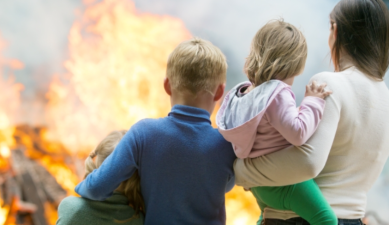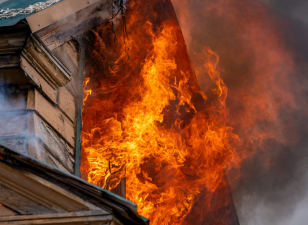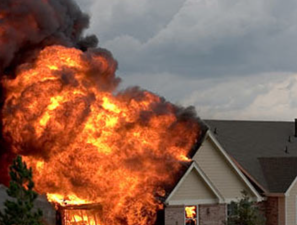Fire, a seemingly distant yet ever-present hazard, often results in significant loss of life and property.
Therefore, understanding and mastering fire safety precautions is crucial for everyone. Fire conditions can change rapidly, and trapped individuals have limited time to escape. So, how should we properly escape when a residential fire occurs?
Fire Prevention
- Home Fire Prevention Measures
Homes are a frequent site of fire, making proper home fire prevention crucial. First, regularly inspect electrical wiring to ensure it is free of aging and damage, and avoid overloading. When using electrical appliances, always follow the instructions in the manual and avoid arbitrarily pulling or connecting wires. Also, develop the habit of turning off unnecessary power, especially when leaving a room or going out.
The kitchen is also a high-risk area for home fires. When using a gas stove, always monitor the flame to prevent oil pans from igniting. If you discover a frying pan fire, do not use water to extinguish it. Immediately turn off the gas and cover the burning pan with a lid or a large wet rag. Additionally, flammable items in the kitchen, such as oil and paper, should be properly stored away from sources of ignition.
Smoking is also a common cause of household fires. Therefore, avoid smoking in bed or on the sofa. Cigarette butts should be completely extinguished before disposal, ensuring they do not ignite surrounding flammable materials. Children should also be taught not to play with fire, and flammable items such as matches and lighters should be kept out of reach of children.
- Fire Prevention in Public Places
Public places such as shopping malls, supermarkets, and office buildings are crowded with people and contain a large number of flammable materials. The consequences of a fire are disastrous. Therefore, these places must strictly adhere to fire safety regulations and be equipped with comprehensive firefighting equipment, such as fire extinguishers, fire hydrants, and emergency lighting, ensuring these facilities are always in good condition.
Additionally, operators and managers of public places should strengthen fire safety training for their employees and conduct regular fire drills to enhance their fire safety awareness and self-rescue skills. Customers and visitors should also be reminded of fire safety through notice boards and announcements, and be familiar with escape routes and the location of fire-fighting equipment.
Fire Escape Tips:
Master These 5 Steps to Save Lives in a Critical Moment
After a fire breaks out, panic and misjudgment can often lead to disastrous consequences. Mastering the correct escape techniques can save you and your family's chances of survival in a critical moment.
- Stay Calm and Determine the Direction of the Fire
Your first reaction to a fire can often mean the difference between life and death. Regardless of the size of the fire, remaining calm is crucial. Quickly determine the fire's location, avoid areas with intense fire, and choose an appropriate escape route.
• If the fire is small and the exit is unobstructed, evacuate quickly toward an emergency exit.
• If the fire is large and smoke is spreading, immediately seek shelter and prepare for smoke damage.
Tip: 80% of deaths in fires are caused by inhalation of toxic smoke, so protecting your respiratory system is paramount!
- Crawl low and cover your mouth and nose with a wet towel.
Dense smoke is a "silent killer" in fires and can quickly cause suffocation or unconsciousness. Crawling low can help avoid smoke, while covering your mouth and nose with a wet towel can effectively reduce the risk of inhaling toxic gases.
• When escaping, stay as close to the ground as possible and avoid areas of dense smoke.
• Wet towels can act as a simple filter, helping you breathe safer air.
Note: If wet towels are insufficient, clothing can be used as a substitute, but they must be kept moist.
- Avoid elevators and choose emergency exits.
In high-rise fires, elevators may malfunction due to power outages or high temperatures, and may even become dangerous "fire traps." Escape stairs are a safer option.
• Familiarize yourself with the location of the escape stairs on your floor so you know how to evacuate in an emergency.
• After a fire breaks out, prioritize following stairway signs to avoid backtracking or pausing to watch.
Special Tip: Families living in high-rise buildings should ensure that stairwells are clear of debris to prevent impediments to escape in an emergency.
- If you are unable to escape, seal door gaps to prevent smoke and signal for help.
If the fire blocks your escape route, immediately implement the "shelter in place" strategy:
• Use wet towels, clothing, or other tools to seal door gaps to prevent smoke from entering the room.
• Close doors and windows to reduce air circulation and slow the spread of fire.
• Use a flashlight, cell phone flashlight, or wave brightly colored clothing to signal for help.
Note: Sheltering in place does not mean "waiting for help and doing nothing." You should monitor the fire situation at all times and identify possible safe opportunities to evacuate.
- Prepare escape tools and practice them regularly.
After a fire breaks out, your home's emergency tools can be the difference between life and death. Preparing them in advance and being familiar with their use is an important step in preventing fires.
• Always have fire extinguishers, escape ropes, and other tools on hand at home, and regularly check their function.
• Be familiar with the procedures for using a fire extinguisher to extinguish small fires to prevent them from spreading.
• Conduct fire drills regularly to ensure that family members, especially children and the elderly, are familiar with emergency preparednes.
Post-Fire Actions
- Waiting for Rescue
If you cannot escape the fire or your escape route is blocked by fire, choose a relatively safe location and wait for rescue. While waiting for rescue, remain calm and composed. Do not call for help or run around. You can attract the attention of rescuers by shouting for help, waving a cloth, or banging on metal objects.
- Treating the Injured
If someone is injured in a fire, provide initial first aid while ensuring your own safety. For example, for burns, immediately flush the wound with cold water to reduce the body's temperature. For those suffering from suffocation or poisoning, immediately perform artificial respiration or CPR. Then, quickly transport the injured to a safe area and to a hospital for treatment.
- Cooperating with the Investigation
After the fire is extinguished, actively cooperate with the fire department's investigation. Provide accurate information about the circumstances surrounding the fire and assist the fire department in determining the cause and extent of the damage. At the same time, we must seriously learn lessons, strengthen fire safety awareness, and prevent similar accidents from happening again.







